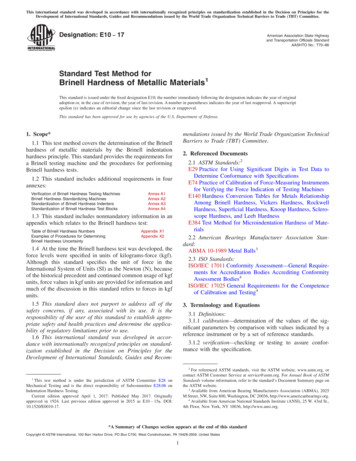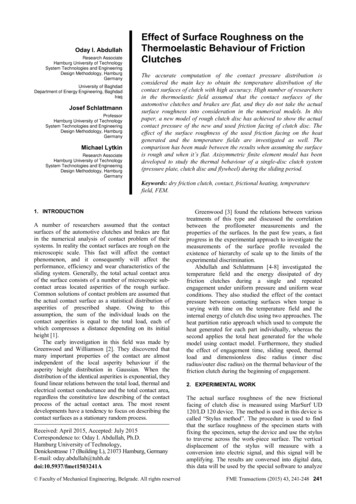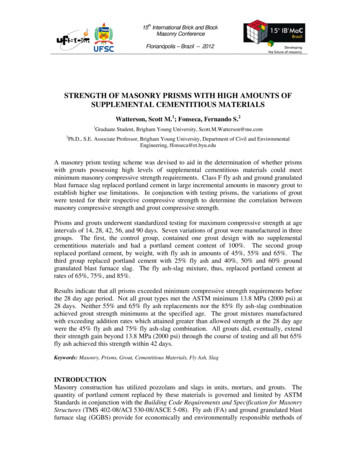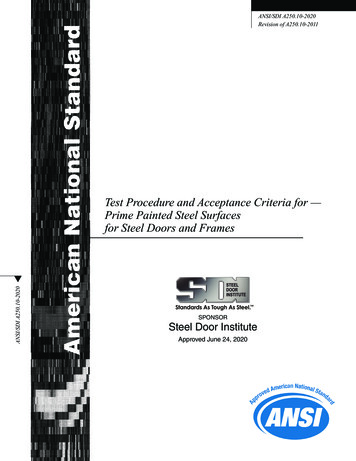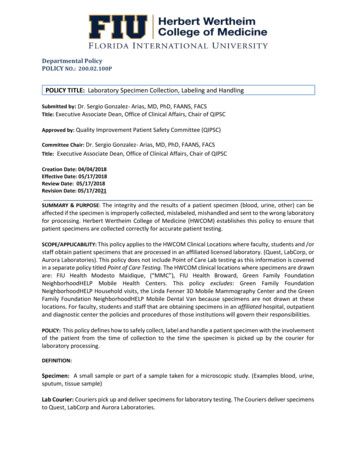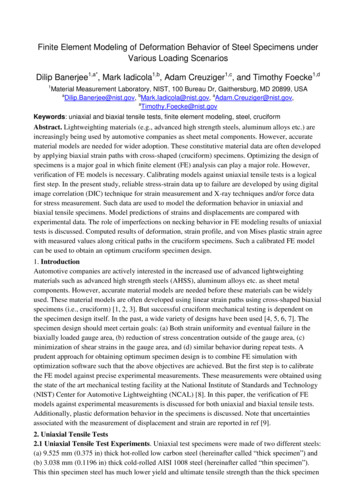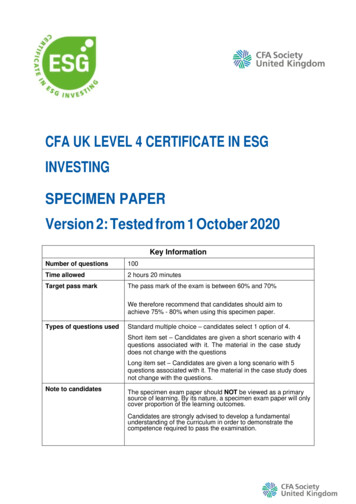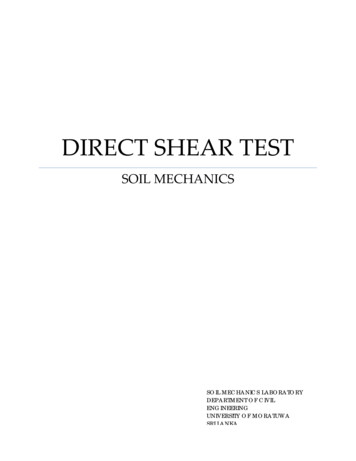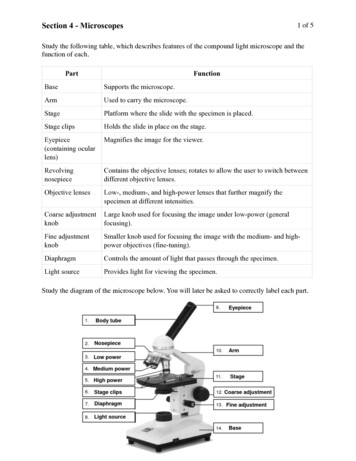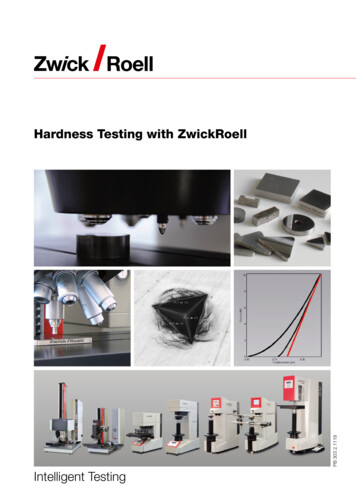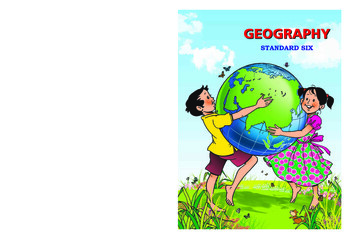
Transcription
(A) A Specimen of a Student’s Activity Sheet(B) A Specimen of a Student’s Activity Sheet(This is a specimen, not a model sheet. Help the children to correct their errors, if any.)
Sanction no. : MSCERT/avivi/sp/2015-16/1673 Date : 06/04/2016GEOGRAPHYSTANDARD SIXMaharashtra State Bureau of Textbook Production andCurriculum Research, Pune.The digital textbook can be obtained through DIKSHA APPon a smartphone by using the Q. R. Code given on title pageof the textbook and useful audio-visual teaching-learningmaterial of the relevant lesson will be available through theQ. R. Code given in each lesson of this textbook.
ENGLISH GEOGRAPHY- STANDARD VI - LEARNING OUTCOMESSuggested Pedagogical ProcessesThe learner may be provided opportunities inpairs/groups/individually and encouraged to :Learning OutcomesThe learner- Understand concepts like angular distance,06.73G.01 Visualizes the angular distances inthree dimensions.latitudes and longitudes, etc. Using globe for understanding latitudes and 06.73G.02 Identifies latitudes and longitudes, forlongitudes.example, the Poles, the equator and Using map/technology to find out the locationthe tropics.of country/state/district/ village/school, etc.06.73G.03 Shows location and extent with thehelp of latitudes and longitudes in themap and globe. Explaining the climate of a place with the help 06.73G.04 Differentiates between climate andof daily winds.weather.Discussing various elements of weather.06.73G.05 Explains the factors affectingIdentifying the average temperature of a placetemperature.with the help of isotherms on a map.06.73G.06 Thinks about the curvature of theCorrelating the distribution of sunrays and theisotherms on the map.temperature zones.06.73G.07 Understands / explains the globalMaking note of temperatures in the newspapersdistribution of temperature on theand with the help of thermometers.basis of thermal zones.06.73G.08 Records temperatures accurately andinterprets them. Understand the importance of oceans and06.73G.09 Explains the importance of oceans todiscuss the reasons behind marine pollution.mankind with examples. Using maps to show oceans on world outline 06.73G.10 Shows oceans on maps and globes.maps. Collect various types of rock samples. Obtain information regarding the rocks found06.73G.11 Explains differences in rock types.06.73G.12 Identifies rock types with the help ofpictures.in the surrounding, rocks used in makinghistorical monuments, houses, etc.06.73G.13 Explains the rock types in Maharashtra Explain the distribution of rock types inwith the help of map.Maharashtra with the help of a map ofMaharashtra. Explaining the use of natural resources giving06.73G.14 Analyses the uneven distribution ofexamples.natural resources on earth. Discussing that the judicious use of the reserves 06.73G.15 Explains the dependence of livingof natural resources is necessary.organisms on natural resources. Collect information regarding the distribution 06.73G.16 Supports the judicious use of naturalof various natural resources like land, soil,resources.water, natural vegetation, minerals, energyresources, etc,. and relating it with India andthe world.
Give examples of process-based and substance-06.73G.17 Classifies energy resources.based energy resources.06.73G.18 Shows the distribution of important Suggesting measures to conserve energyenergy resources like mineral oil andresources.coal. Correlating on the basis of thedifferences 06.73G.19 Classifies various human occupations.between various occupations.06.73G.20 Correlates various human occupations. Interpreting the pie charts showing variousoccupations. Visiting an occupation in the locality, collectinginformation and discussing it. Understand the difference between uses ofmaps and globes. Collecting06.73G.21 Tells the difference between a globeand a map.06.73G.22 Uses maps and globes.information regarding various 06.73G.23 Verifies the information regardingoccupations by visiting them and correlatingoccupations through field –visits.them.
CONTENTSS. No.ChaptersAreaPage No.ExpectedNumber ofPeriods1.The Earth and the GraticuleGeneral Geography01102.Let us Use the GraticuleGeneral Geography10103.Comparing a Globe and a Map;Practical GeographyField Visits16124.Weather and ClimatePhysical Geography19065.TemperaturePhysical Geography23106.Importance of OceansPhysical Geography31107.Rocks and Rock TypesPhysical Geography40108.Natural ResourcesHuman Geography45109.Energy ResourcesHuman Geography511010.Human OccupationsHuman Geography6010Glossary66-69S.O.I. Note : The following foot notes are applicable : (1) Government of India, Copyright : 2016. (2) The responsibility forthe correctness of internal details rests with the publisher. (3) The territorial waters of India extend into the sea to a distance oftwelve nautical miles measured from the appropriate base line. (4) The administrative headquarters of Chandigarh, Haryanaand Punjab are at Chandigarh. (5) The interstate boundaries amongst Arunachal Pradesh, Assam and Meghalaya shown on thismap are as interpreted from the “North-Eastern Areas (Reorganisation) Act. 1971,” but have yet to be verified. (6) The externalboundaries and coastlines of India agree with the Record/Master Copy certified by Survey of India. (7) The state boundariesbetween Uttarakhand and Uttar Pradesh, Bihar and Jharkhand and Chattisgarh and Madhya Pradesh have not been verified bythe Governments concerned. (8) The spellings of names in this map, have been taken from various sources.DISCLAIMER Note : All attempts have been made to contact copyright holders ( ) but we have not heard from them. We will bepleased to acknowledge the copyright holder (s) in our next edition if we learn from them.Front Cover : A girl and a boy hugging a globe. Back Cover :Various photographs according to the content of thechapters. (1) Mining (2) Samples of rocks (3) Modern weather instruments (4 ) Bhedaghat (5) Power generation centre(6) Collection of rubber latex (7) Coconut grove (8) Agriculture (9) Water transport (10) Pollution of sea water andair due to oil spill and fire.
- For Teachers P To begin with, get familiar with the textbookyourself.given in the chapters. Please ensure that ithelps to create interest in the subject.P Please plan carefully and independently forthe activities in each chapter. Please do notteach without planning.O The present book has been prepared forconstructivist and activity-based teaching.Please do not teach the lessons in the bookby just reading them aloud.P The teaching-learning interactions, processesand participation of all students are verynecessary and so is your active guidance.P Please use the geographical teaching aids inthe school as required for the appropriateunderstanding of the subject. It is necessaryto use the globe, the maps of the World, Indiaand the State, atlases and thermometers.P Though the number of chapters has beenreduced, the number of periods required foreach chapter has been given a thought.Abstract concepts are difficult to follow andtherefore you are expected to use the givennumber of periods fully. This will help thestudents to assimilate the content withoutfeeling the ‘burden of learning’.P Like other social sciences, geographicalconcepts too are not easy to understand.Major concepts of geography have a scientificbase and they deal with abstractions.Encourage group work, learning througheach other’s help, etc. Facilitate peer learningas much as possible by reorganizing the classstructure frequently.P You will find that the character ‘Globee’appears in different boxes and instructionsP Follow the order of the chapters as given inthe contents because the concepts have beenintroduced in a graded manner to facilitateknowledge-building.P Do not use the boxes titled ‘Do you know?’for evaluation.P A glossary is given at the end of the book.Detailed information of importantgeographical terms / concepts in the chaptersis given in this glossary. The words are givenalphabetically. The words included in theglossary are enclosed in blue highlights in thechapters, e.g. Bhuvan (Chapter 1, Page 7)P Some websites have been given for referenceat the end of the chapter and the glossary.Also, a list of references used is also given.You as well as the students are expected touse these references. These references willsurely help you to go beyond the textbook.Please bear in mind that extra reading isalways helpful for understanding any subjectin depth.P Use thought-provoking, activity-oriented,open-ended, multiple choice questions forevaluation. Some examples are given at theend of the chapters in the ‘exercises’.- For Students The character ‘Globee’ will meet you in every chapter. Have you guessed whohe is ? He will help in the various tasks you are expected to do. Try to followhis instructions.
1. The Earth and the GraticuleMake friends with Figure 1.1 : WorldObserve figure 1.1 and answer the followingquestions:Graham, Katya, Michico, Natalia, Minakshi,Shahid and Enrike have answered the abovequestions differently using directions andsubdirections. The Taj Mahal is located at one andthe same place and that is Agra. However, wheneach one of the children told the direction from theirrespective places, their answers were different.This means that the use of directions alone doesnot help us to accurately describe the location ofa place. That is why, it became necessary to finda new system to state the precise location of anyplace on the earth.Let us see what it is! Which places are shown on the map? In which city is the Taj Mahal located? In which continent is the Taj Mahal located? In which direction is the Taj Mahal located forGraham in St. Petersburg, for Katya in Kimberley,for Michiko in Tokyo and Minakshi in Port Blair? Shahid in Agra is specifying the directions inwhich the others live. How will he express them? In what direction will Natalia in Rome andEnrike in Lima say the other child lives? Will theiranswers be the same?1
* Angular DistanceThink a little!Observe the globe in your school. Thinkabout the following questions and then discussthem. There are some vertical and horizontallines on the globe. Which of these lines aremore in number? What labels do these lines have? Whatsimilarities and differences do you see inthe labels? Will it be possible to actually draw suchlines on the earth?12714 KilometresExplanation12756 KilometresFigure 1.2 : Earth’s SizeFigure 1.2 shows the lengths of the eastwest and north-south diameters of the earth.This will give you some idea about the sizeof the earth. Oceanic waters, uneven natureof the land, forests, innumerable islandsof different sizes, and buildings make itimpossible to actually draw such lines on theearth. In order to overcome this difficulty,geographers developed a miniature model ofthe earth in the form of a globe . This can beused to determine locations on the earth. Onecan actually draw horizontal and vertical lineson a globe though not on the earth. Thus, theyare imaginary lines on the earth.EquatorialPlaneN.S.Figure 1.3 : Angular Distance -1The location of any place on the earth isdetermined with reference to the centre of the earth. Inorder to do it, we consider a straight line joining thepoint on the surface and the centre of the earth. At thecentre, it makes an angle with the plane of the equator.The measure of this angle is used in determining thelocations. For example, in figure 1.3, the measure ofangle XMV is 30 . That is, its angular distance from theequator is 30 . Look at the figure and tell the angulardistance of ‘Y’ from the equator.Figure 1.3 shows another plane. It passesthrough X. It is parallel to the plane of the equator.Observe 1.3 and see how it meets the surface of theearth. Note that it forms a circle on the surface. Anypoint on this circle and the equatorial plane form anangle of 30 at the centre of the earth.Do it yourself !Use figure 1.4 for the following: In the upper portion of the circle, at the centre X,draw angles of 20 , V1X K1 and V2X K2 ; K1 andK2 being the points on the circle. Draw an ellipsejoining K1 and K2. In the lower half of the circle, mark angles of 60 and name the points on the circle as P1 and P2. Draw an ellipse joining P1 and P2.2
NorthNorth50 40 30 70 80 90 80 70 Earth’s Centre60 50 40 30 20 10 XV160 Earth’s Axis20 10 0 0 V2Axial AngleEquatorEquatorial PlaneSouthSouthFigure 1.5 : Parallels of LatitudeFigure 1.4the equator as shown in figure 1.5. That is why, theequator is considered as 0 parallel. It is the largestparallel, and also a great circle. The angular distanceof other parallels towards north and south goes onincreasing away from the equator.Can you tell? Are the distances between K1 K2 and P1 P2 thesame? Compare the distances XK1 and XP2. Are thesedistances the same or are they different?Use your brain power! Now compare the ellipses you have drawn. Which is the larger ellipse? Why?Explain the meaning of the term equator.ExplanationThe equator bisects the earth into north andsouth parts. The one to the north is called thenorthern hemisphere while the one to the southis called the southern hemisphere . Towards thenorth and south of the equator, parallels of latitudeprogressively become smaller and smaller. On theglobe (and also on the earth), at the north and southends of the earth’s axis, they appear as points. Theseare called the North Pole and the South Polerespectively.* Parallels of LatitudeYou must have realized that the ellipse drawnby joining the 20 points is larger than the ellipsethat joins the 60 points. However, the distancesX K1 and X P2 are the same. This is because we aredealing with a sphere.Note that though these lines appear to beellipses in the diagram, on the globe they arecircles. The circles thus created at some angulardistance from the centre of the earth are parallelto one another. Hence, they are called parallels ofthese latitudes . The values of parallels are angularmeasures expressed in degrees.While mentioning the value of a parallel, it isnecessary to mention whether it is in the northernor southern hemisphere. The parallels from thenorthern hemisphere are referred to as 5 N, 15 N,30 N, 50 N whereas the parallels from the southernhemisphere are referred to as 5 S, 15 S, 30 S, 50 S.The degrees of the parallels are measured from3
90 North PoleEarth’s Axis30 North Latitude30 North Latitude0 imPreudan . loWidier90eMitngCairoन्यु ऑर्लियन्सNew ��रEarth’s30 Latitude30 East Longitude90 LongitudeHarareEquatorDurbanEquatorialPlane20 South ParallelFigure 1.6 : Earth’s Angular MeasurementsA line joining all the places located to thenorth of the equator at an angular distance of 30 is 30 north parallel. Hence, all the places on thisparallel will be at the same latitude, which is 30 N.New Orleans in North America, Cairo in Africa orBasra and Lhasa in Asia are all located on 30 Nparallel. The same concept holds good for all otherparallels. See figure 1.6.Do it yourself ! Take an orange and peel off its skin. You willsee the segments inside and thin vertical lineson them. Carefully take out one segment. Observe thesegment and the gap it has left in the orange.See figure 1.7One can draw 181 parallels on the earth at theinterval of 1 . At 0 , that is, the equator. See if the shape of the central and terminalportion of the segment is the same or different. 90 parallels in the northern hemisphere -1 Nto 90 N. See if the angle of the gap is the same at allpoints. 90 parallels in the southern hemisphere -1 Sto 90 S. Find how many segments there are in an orange.4
Figure 1.7being spherical, we consider 360 withrespect to the earth as well. An orange is spherical, with a circular crosssection. There are 360 in a circle. The earthsemicircle that passes through B and joins theNorth and South Poles. Trace it. Now join MC. Measure AMC and write it nextto C. Draw a semicircle that passes through ‘C’and joins the North and South Poles. Draw a line that passes through point A at 0 ,and joins the North and South Poles.North PoleFigure 1.8 : Angular Distance - 2In figure 1.8, ABC, DEF, GHI have thesame measure, 50 . However, the distances betweenA and C, D and F and G and I, are different whenmeasured on the earth’s surface. That is becausethe earth is spherical in shape.EquatorMBADo it yourself !Use figure 1.9 to do the following:Let the line AM be 0 . Draw the line MB. Measure the angle it makeswith the line AM and write it near B. Note theSouth PoleFigure 1.95C
The distance between any two adjacentparallels is 111 km on the surface of the earth.The distance between two adjacent meridiansis also 111 km on the equator. To locate theplaces within this distance of 111 km exactly, weneed to divide the unit degree into smaller units.Degrees are divided into minutes, and minutesinto seconds. Conventionally, latitudes andlongitudes are expressed into degrees, minutesand seconds. Each degree is divided into 60minutes and a minute into 60 seconds. Thesevalues are expressed using the symbols degrees( ), minutes ( '), seconds ( '').Explanation* Meridians of LongitudeYou will realize that the lines drawn frompoints A, B and C make angles at M, the centreof the earth on the plane of the equator. Throughthese points, we can draw semicircles joining boththe poles. Starting with point A, we can drawsimilar semicircles through points placed at eachdegree. These semicircles are known as meridiansof longitude .One of these meridians is considered tobe 0 . It is known as the Prime Meridian . Theangular distances of the other meridians fromthe Prime Meridian are measured in degrees andare called longitudes. You have done this in theactivity based on figure 1.9. The 0 and 180 meridians lie opposite on the globe, forming acircle. This circle divides the earth in the easternand western hemispheres. All meridians are equalin size.In all, we can draw 360 meridians, each ata distance of 1 . 0 Prime Meridian 180 meridian 1 East to 179 East meridians. Thus,we have 179 meridians in the easternhemisphere.Meridians in the eastern hemisphere arelabelled as 10 E, 25 E, 135 E, etc. while in thewestern hemisphere they are labelled as 10 W,25 W, 135 W etc. 1 West to 179 West meridians. Thus 179meridians in the western hemisphere.30 E is the semicircle that joins all placesat an angular distance of 30 from the PrimeMeridian. Some of them are Cairo, Harare andDurban in Africa. See figure 1.6.Think a little!A game of reading the meridians on the worldmap is going on. Shaheen and Sanket areasking each other to locate places on specificmeridians and are making notes of the same.Shaheen asks Sanket to locate Wrangel Islandon 180 meridian. Sanket could locate theisland in the map but both are confused whilemaking a note of it. They are puzzled whetherto write 180 E or 180 W? What would be theprecise answer? Please help them. Can we usea similar logic with reference to 0 meridianas well?Though the earth is huge in size, we can tellthe exact location of places on the earth usinglatitudes and longitudes. Note that the distancebetween two adjacent parallels is the sameeverywhere but the distance between two adjacentmeridians is not the same everywhere. We cansee this even on the segment of an orange. Thedistance between the meridians is the maximumon the equator and goes on reducing towards thePoles. At the Poles it is zero.6
longitudes. This technology is also available onmobile phones and motor cars.Do you know?The distance between any two consecutivemeridians is different on different parallels.It is maximum on the equator and it is zeroon both the Poles.Equator – 111km.Tropic of Cancer/Capricorn – 102 km.Polar circles (Arctic / Antarctic) – 44 kmPoles (North / South) – 0 km* The GraticuleFigure 1.11 : G.P.S. InstrumentDo you know?Indian Regional Positioning System:India has achieved self-reliance in GlobalPositioning Technology. With the help ofIRNSS (Indian Regional Navigation SatelliteSystem), locating any place in the Indiansubcontinent is going to be easy. For this,India is launching its own series of 7 satellites.It will then be possible to locate any place inthe region of South Asia and the Indian Oceanprecisely.Figure 1.10 : The GraticuleUse your brain power!The parallels and meridians on the globe forma net that is called a graticule . This facilitatesdetermining the location of a place. See figure 1.10How many parallels and meridians can bedrawn on a globe at an interval of 10 ?Thus we use latitude and longitudefor determining the locations on theearth. This method is being used evenin today’s modern age quite effectively.Geographical Information System(GIS),Global Positioning System(GPS) as alsoGoogle Maps, Wikimapia and Bhuvan of ISROon the internet also make use of latitudes andI can do this! Express the angular measures of latitudeand longitude on a globe/map. Read parallels of latitude and meridians oflongitude. Draw a graticule on a spherical object.7
Exercises(A) Place a tick mark P against the correct option. (C) Find the correct graticule out of the followingand put a tick mark P against it.(1) What term is used for the imaginary eastwest horizontal lines on the earth?NMeridians International Date Line Parallels (2) What is the shape of the meridians?Circular Semicircular Points (3) What do the parallels of latitude andmeridians of longitude together form on theglobe?Angular distance SNHemisphere Graticule (4) How many parallels are there in the northernhemisphere?90 89 91 (5) Which circle forms the eastern and westernhemispheres?0 parallel and 180 meridian 0 Prime Meridian and 180 meridian North and South Polar circles S(6) Which circle appears as a point on the globe?NEquator North / South Pole Prime Meridian (7) How many places on the earth may belocated on 45 N parallel ?one many two (B) Observe a globe and examine the followingstatements. Correct the wrong ones.(1) Parallels of latitude lie parallel to the PrimeMeridian.(2) All parallels of latitude converge at theequator.(3) Parallels and meridians are imaginarylines.(4) 8 4' 65'' is a north meridians.(5) Meridians are parallel to each other.SN S8
(D) Answer the following :(1) How will you express the latitude andlongitude of the North Pole?(2) How much is the angular distancebetween the Tropic of Cancer and Tropicof Capricorn?(3) Using a globe, write down the names ofthe countries through which the equatorpasses.(4) Write down the main uses of the graticule.Look at the photographs.(E) Complete the following table.Characteristics Parallels oflatitudeShapeSize* ActivityTry to draw a graticule on a ball.Meridians oflongitudeSize of eachparallel isdifferent.DistanceDistancebetween twomeridians islarger on theequator and thesame decreasestowards thePoles.Graticule for special children.Websites for reference http://www.kidsgeog.com http://www.youtube.com http://www.wikihow.com https://earth.google.com9
2. Let us Use the Graticule Which oceans are spread in all the fourhemispheres?Make friends with the globe! Which continents are spread in all the fourhemispheres? At which two parallels do all the meridiansconverge?When we talk about various places, regions,rivers, roads, etc. we are actually talking withreference to the earth. The location of a place,the extent of a region and the extent of any linearfeature can be described precisely with the help ofparallels and meridians. Let us see how to use thegraticule for this purpose.Figure 2.1 : The GlobeObserve the globe and answer the following. What are the horizontal lines on the globecalled?Verify the following description with the helpof a world map or a globe in the school. List the continents and oceans through whichthe equator passes. While describing the location of a place, weneed to consider only one parallel and one Encircle the intersection of 0 meridian and 0 parallel on the globe.ARCTIC OCEANEUROPENORTHAMERICAAFRICAANATL0 ASIAPACIFIC OCEANCEAOTICSOUTHAMERICAPACIFIC OCEAN0 NAUSTRALIASOUTHERN OCEANANTARCTICAFigure 2.2: World MapThe Equator and the Prime Meridian are labelled in degrees in figure 2.2. Can you write thevalues of other meridians and parallels?10
meridian, e.g., Delhi is located at 28 36' 50'' Nlatitude and 77 12' 3'' E longitude. Which latitude and longitude define the location For describing the extent of a region we needto consider two parallels and two meridians atthe extreme ends of the region. For example,the extent of Australia is described as10 30' S to 43 39' S latitude and 113 E to153 E longitude. What would be the longitudinal extent of Brazilof the capital of Brazil – Brasilia?that spreads from 5 15' N to 33 45' S latitude? In which hemispheres does Brazil extend in thenorth - south direction? In which hemisphere does Brazil extend in theeast - west direction? For describing the extent of linear featureslike a river, road etc., we need to considerthe latitude and longitude of their terminalpoints. For example, the River Nile in Africaoriginates in Lake Victoria, flows northand meets the Mediterranean Sea near thecity of Alexandria inEgypt. The locationof Lake Victoria islatitude0 45' 21''Sand33 26' 18''Elongitude. Similarly,thelocationofAlexandria is 31 12' Nlatitudeand29 55'07''Elongitude.Theselatitudesand longitudes areconsidered to describethe extent of the RiverNile. This extent isfrom 0 45'S latitudeand 33 26'E longitude(origin) to 31 12'Nlatitude and 29 55'Elongitude (up to themouth). Which parallels and meridians should be usedto describe the extent of River Sao Francisco? Describe the location of Marajo island usingthe graticule.Make friends with maps!* Let’s use the graticule.Answer the followingquestions about locationand extent with the help offigure 2.3.Figure 2.3 : Map of Brazil11
* Important Parallels and MeridiansNorth Pole90 66 30' N (Arctic Circle)180 Longitude23 30' N (Tropicof Cancer)Area of perpendicular raysArea of slanting rays (Day up to 24 hours)Area of very slanting rays (Duration of day more than 24 hours)0 Longitude0 (Equator)23 30'S(Tropic ofCapricorn )90 South Pole66 30' S (Antarctic Circle)Figure 2.4 : Important CirclesLet us get acquainted with some importantparallels and meridians.Think a little! All places between 23 30' north and south ofequator receive perpendicular rays on two daysin a year. Other areas of the earth never getperpendicular rays. The parallels at 23 30' Nand 23 30' S of equator are calledTropic of Cancer and Tropic of through India? Which areas do not getperpendicular sunrays? Which regionreceives perpendicular rays on two daysin a year? Show these regions by differentcolours on a map of India. The parallels at 66 30' north and south of theequator are also important parallels. In thearea between these two parallels, throughoutthe year, daytime lasts within the limit of 24hours. These are called the Arctic Circle andthe Antarctic Circle respectively.appearance in the sky can be of six monthsat the Poles based on the seasons. During thisperiod, the sun continues to move in a spiral onthe horizon.We have seen in Std V that the earth’s axis isinclined. These important parallels arise becauseof its inclination by 23 30'. Depending on the seasons, daytime (sun beingvisible in the sky) can be greater than 24 hoursin the areas between the polar circles and thePoles. The maximum duration of the sun’s Due to the duration and intensity of sunlight,12
Do you know?12 21 ' 00 '' E12 21 ' 30'' E41 54' 30 '' NVaticanCityisknown as the smallestcountry in the world. Itis spread over an areaof 0.44 sq. km. Thiscountry is locatedwithin Italy on theItalian peninsula. Seethe latitudinal andlongitudinal extent ofthis country in figure2.5. From west toeast and also fromnorth to south, thereis no difference in thedegrees or minutes oflatitude or longitudebut the difference isonly in seconds. Fromthis, you will get anidea about the useof the smaller units of minutes and seconds inangular measurements.41 54 ' 00 '' NFigure 2.5 : Map of Vatican Citydifferent temperature zones are formed on theearth. These zones give rise to pressure belts.The International Date Line is marked withreference to this meridian. Variation in the intensity of sunlight leads toregional diversity in plant and animal life. The equator as well as all pairs of oppositemeridians form Great Circles. Great Circles areused for finding the minimum distance betweenany two places on the surface of the earth. The 0 longitude or Prime Meridian is animportant meridian. The main purpose of this isto fix the global standard time and coordinatethe standard times of different countries. Thismeridian is also called as Greenwich Meridian.Global standard time is known as GMT –Greenwich Mean Time.Think a little!(1) Find on the globe, the meridians opposite tothe ones mentioned below: The 180 meridian is also important. Fromthe Prime Meridian, other meridians aremarked east and west up to 180 . The 180 meridian lies opposite to the Prime Meridian.90 E, 170 W, 30 E, 20 W.(2) What do you observe?13
I can do this!Use your brain power! Show the important meridians and parallels onthe map.In what direction should an aeroplanefly in order to cover the shortest distancebetween Kolkata and Chicago? Identify and make use of the important parallelsand meridians. Describe the location and extent of any place,region, river, road, etc. in the world precisely.Exercises(A) Put a tick mark against the correct option inthe space given.(B) Read the following statements and correctthe wrong ones.(1) 66 30' North parallel means(1) While describing the location of a placeEquator mentioning the meridian is sufficient.Arctic Circle Antarctic Circle Atlantic Ocean (6) 8 4' N parallel to 37 66 N para
Maharashtra State Bureau of Textbook Production and Curriculum Research, Pune. GEOGRAPHY The digital textbook can be obtained through DIKSHA APP on a smartphone by using the Q. R. Code given on title page of the textbook and useful audio-visual teaching-learning mate

